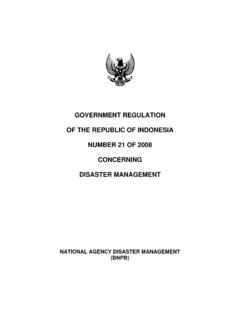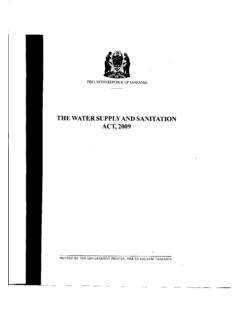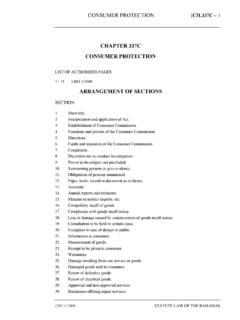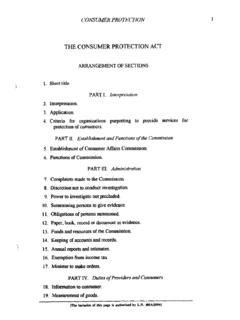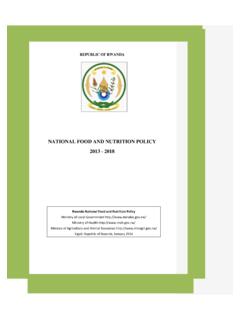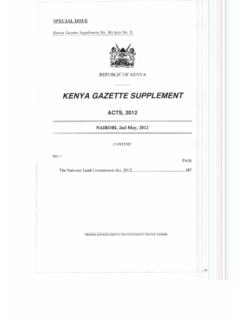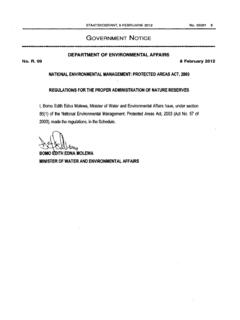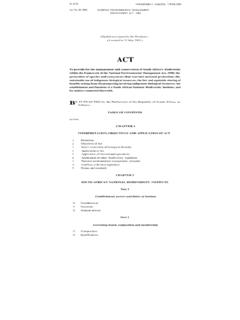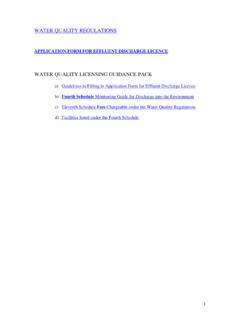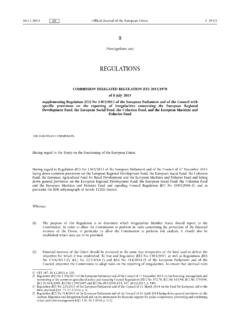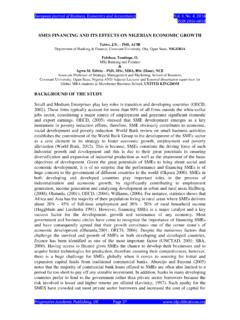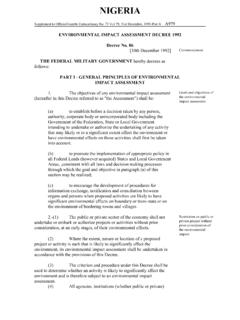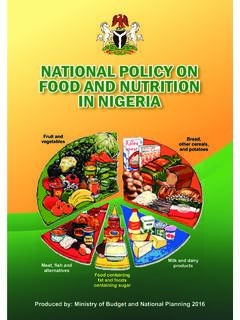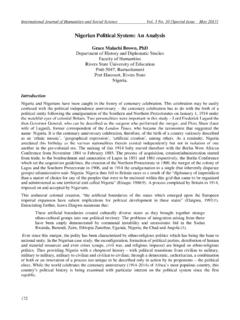Transcription of AGRICULTURAL POLICY FOR NIGERIA
1 AGRICULTURAL POLICY FOR NIGERIA FEDERAL MINISTRY OF AGRICULTURE, WATER RESOURCES AND RURAL DEVELOPMENT, ABUJA REPRINT 2 CONTENTS Page CHAPTER ONE: INTRODUCTION The Role of the AGRICULTURAL Sector Evaluation of AGRICULTURAL Sector s Performance Agriculture s Share of the Gross Domestic Product Employment generation in the AGRICULTURAL Sector Source of Foreign Exchange Earnings Food for an increasing Population Raw Materials for industries Market for the Products of the Industrial Sector Problems of the AGRICULTURAL Sector Technical problems Socio-Economic Problems Organisational Problems Institutional Problems Objectives of the AGRICULTURAL Sector Outline of Presentation CHAPTER TWO MACRO POLICIES AND AGRICULTURE Pricing POLICY Trace POLICY Exchange Rate POLICY AGRICULTURAL Land
2 POLICY CHAPTER THREE AGRICULTURAL SECTOR POLICIES AND STRATEGIES Food Production Food Crop Production Livestock Production Fish Production Industrial Raw Material Production Industrial Crop Production AGRICULTURAL By-Products Forest Products and Wildlife CHAPTER FOUR POLICY ON SUPPORT SERVICES 3 AGRICULTURAL Extension Technology Development and Transfer AGRICULTURAL Credit AGRICULTURAL Insurance AGRICULTURAL Produce Marketing AGRICULTURAL Commodity Storage AGRICULTURAL Commodity Processing AGRICULTURAL Research AGRICULTURAL Cooperatives Land Resources Pest Control AGRICULTURAL Mechanisation Water Resources Development Rural Infrastructure AGRICULTURAL Strategic and Data Bank AGRICULTURAL investment and Management Advisory Services AGRICULTURAL Manpower Development and Training CHAPTER FIVE: ROLES AND RESPONSIBILITIES Responsibilities of various Tiers of Government Federal Government State Government Local Government The Role and Responsibilities of the Private Sector Mechanism for Periodic POLICY Review POLICY Stability Perspective Plan 4 CHAPTER ONE INTRODUCTION Before the decade of the 1960s, the dominant role of agriculture in NIGERIA s economy was taken for granted.
3 With very little support from government, nigerian agriculture was able to grow at a sufficient rate to provide adequate food for an increasing population, raw materials for a budding industrial sector, increasing public revenue and foreign exchange for government and employment opportunities for an expanding labour force. The little support provided by government for AGRICULTURAL development was concentrated on export crops like cocoa, groundnut, palm produce, rubber and cotton as self-sufficiency in food production seemed not to pose any problem worthy of public attention. Indications of problems in the nigerian agriculture, however, started to emerge as from the first decade of the country s independence (1960 69).
4 These indications were clearly evident from increasing food supply short-falls, rising food prices and declining foreign exchange earnings from AGRICULTURAL exports. However, not much rational concern was shown because the problems were thought to be the temporary effects of a series of crises which eventually culminated in the civil war (1967 70). The second decade of NIGERIA s independence (1970 79) witnessed a rapid deterioration in the country s AGRICULTURAL situation. Not only were there widening food supply-demand gaps and rising food import bills, there were also rapid declines in government revenue from agriculture, in foreign exchange earnings from AGRICULTURAL exports and in the labour force required in agriculture.
5 The situation was further compounded by the residual effects of the civil war, severe droughts in some parts of the country, government fiscal and monetary policies and above all, an oil boom which created serious distortions in the economy and accelerated the rate of migration of labour from agriculture. In an effort to tackle these serious problems, government initiated a number of AGRICULTURAL policies, programmes and projects, largely within the framework of three successive rational development plans from 1970 to 1974, from 1975 to 1980 and from 1981 to 1985. Experience from these policies, programmes and projects have however, convinced the government and all those concerned with AGRICULTURAL development efforts in NIGERIA that there is no alternative to well-designed and articulate AGRICULTURAL policies as instruments for promoting AGRICULTURAL growth and development in NIGERIA .
6 It is therefore, in realization of this fact that the government has adopted a comprehensive package of POLICY instruments to further develop and improve the 5 performance of the country s AGRICULTURAL sector. These POLICY instruments are expected to remain valid for about fifteen years that is up to year 2000 The Role of the AGRICULTURAL Sector Agriculture has traditionally been characterized as the mainstay of the nigerian economy with many assigned roles to perform in the course of the country s economic development. Among the roles conventionally ascribed to the AGRICULTURAL sector in a growing economy are those of (i) Providing adequate food for an increasing population (ii) Supplying adequate raw materials to a growing industrial sector (iii) Constituting the major source of employment (iv) Constituting a major source of foreign exchange earnings: and (v) Providing a market for the products of the industrial sector The evaluation of the performance of the nigerian AGRICULTURAL sector should therefore be based on the extent to which these above-named roles have been satisfactorily performed.
7 In addition, the overall importance of agriculture in the economy as indicated by the AGRICULTURAL sector s share of the Gross domestic Product (GDP), should be critically examined. Evaluation of AGRICULTURAL Sector s Performance Agriculture s Share of the Gross Domestic Product In the 1960 69 period, the AGRICULTURAL sector s share of which will ensure that AGRICULTURAL resources and services are directed to small-scale farmers with a view to improving their resources productivity and increasing their AGRICULTURAL output. This will be promoted through the net work of AGRICULTURAL Development Projects (ADPs). (a) The government is however, aware of the limitations of a small-scale farming strategy in an environment marked by a steady outflow of young able bodied farm workers from the rural areas and the ageing of the farming population left behind.
8 In the circumstance, reliance on the small-scale farming strategy alone may provide only a short-term solution to the country s AGRICULTURAL problems unless government policies succeed in inducing a backward flow of the youths into farming. Taking this factor into consideration, government will pursue a concurrent strategy of fostering the development of medium-scale and large-scale commercial AGRICULTURAL production systems to complement the small-scale strategy. 6 (b) Medium/Large-Scale Farming: It is believed that NIGERIA will witness a steady decline in the number of small-scale farmers and a gradual increase in the average size of farms in the coming decades.
9 In recognition of this fact, government will pursue a strategy which permits medium and large-scale farms to thrive side by side with small scale ones. There are, however, other considerations that favour a large scale farming strategy. First is the belief that a large scale farming system offers the opportunity for land consolidation and offers a wide scope for increased productivity through the application of scientific management techniques, the use of modern inputs and the efficient utilization of productive farm resources due to economies of scale. Second is the relative ease and the low cost of handling and marketing large bulks of AGRICULTURAL commodities produced under the large-scale farming system.
10 Third is the employment generating potential of large scale farming in the rural areas not only directly through large-scale AGRICULTURAL production activities but also indirectly through agro-allied industries that large-scale AGRICULTURAL production establishment are likely to attract. Therefore, where the pressure on land is not very great, potential large-scale farmers will be assisted to acquire land. Large-scale farmers will also benefit from a liberal import POLICY in respect of AGRICULTURAL machinery, equipment and materials. (c) Backward integration: Under this strategy, agro-industries will use modern small-scale contract farmers to undertake the production and supply of AGRICULTURAL raw materials required by them.
